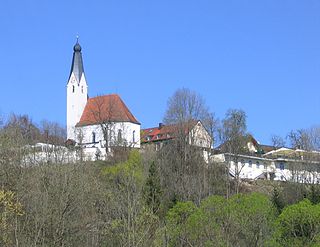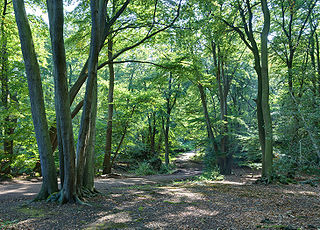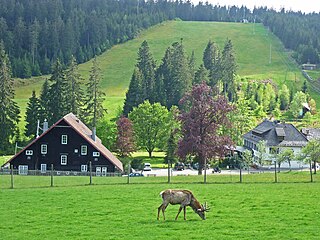Distribution

Of the regions, Oceania, North and Central America and South America have the highest proportions of private forests. [2]
Europe
European Union
In the European Union (EU-28) 42% of the area is covered by forest. 60% of the European forest area is private. The share of private forest area is ranging from 13% in Bulgaria up to 98% in Portugal. [8] Almost all European private forest is small holdings, only 1% of European private forest holdings have units over 50 ha. [9]
Austria
Forest cover approximately 40.000 km² which represent 48% of Austria. 82% of the forest area is in private ownership. Most private forest owner held small forest (under 200 hectare). [10] Traditionally, private forest owner in Austria were predominantly farmers and forest were used to cover the personal needs of wood products and occasionally to finance larger investments. Due to societal change and the associated urbanization a new group of “remote urban forest owners” have emerged. These are owners of small-scale forest, who predominately have inherited but do not manage or actively cultivate their forest. Meanwhile one third of private forest owners belong to this new group. [11]
Catalonia (North-East Spain)
Around two thirds of total area of Catalonia (32,108 km2) is covered by forests (2,050,000 ha) and 75% of this surface are private forests. Forests ownership is scattered and with a large proportion of small properties (221,779 private states, probably more than 260,000 forest owners). The mean surface of the forest estates of Catalonia is 6.7 ha. Moreover, the 52 % of the forest estates do not exceed 1 ha, even they represent just the 2.8% of the private forest area. Just 4.75 % of the properties have more than 25 ha, although they represent the 67.25% of the global private forests and only 1.2 % of private properties are bigger than 100 ha (represent 41.5% of the total private forest area).
Some forest states are also linked to agriculture activities (actually, decreasing), apart from forest activities. Ownership, traditionally, has been passed from parents to their children. Family heritage is estimated to account for 60% of the transmissions.
There is no any concrete definition of small scale forest owners, the definition depends on many aspects. However, in Catalonia, law defines as minimum forest unit, 25 ha
Germany
Germany has around 11.4 million hectares of woodland of which 48.0 percent is in private ownership. The state of North Rhine-Westphalia has the greatest proportion of private forest (66.8%); Hesse has the lowest proportion (24.5%). [12] In Germany there are just under 2 million private forest owners. The average size of German private woods is 3 hectares. Only 13% of private woods are over 1,000 hectares in area; 50% of the area is made of up small private forests of up to 20 hectares in area and they account for 98% of the owners. The DBU Naturerbe, with around 60,000 ha, is the largest private forest owner in Germany. [13] [14] Of the churches in Germany, around 150,000 ha of forest is divided between 6,500 legal owners (parishes, abbeys, foundations, bishoprics). Even though the churches are mostly corporate bodies, the woodlands they own are considered to be private forests. [15]
| Federal state | Private forests up to 20 ha [16] | Private forests over 20 to 50 ha [16] | Private forests over 50 to 100 ha [16] | Private forests over 100 to 200 ha [16] | Private forests over 200 to 500 ha [16] | Private forests over 500 to 1,000 ha [16] | Private forests over 1,000 ha [16] | Private forests total [16] |
|---|---|---|---|---|---|---|---|---|
| Baden-Württemberg | 242,232 ha | 50,628 ha | 28,516 ha | 19,210 ha | 20,611 ha | 17,510 ha | 114,162 ha | 492,869 ha |
| Bavaria | 950,045 ha | 159,527 ha | 69,758 ha | 49,359 ha | 61,725 ha | 49,726 ha | 110,839 ha | 1,450,979 ha |
| Brandenburg + Berlin | 254,678 ha | 75,021 ha | 35,536 ha | 31,193 ha | 69,493 ha | 70,678 ha | 102,661 ha | 668,479 ha |
| Hamburg + Bremen | 6,725 ha | - | 791 ha | - | - | - | - | 7,516 ha |
| Hesse | 67,983 ha | 5,999 ha | 9,998 ha | 18,395 ha | 26,793 ha | 19,595 ha | 69,983 ha | 218,746 ha |
| Mecklenburg-Vorpommern | 64,575 ha | 16,591 ha | 17,286 ha | 28,115 ha | 32,188 ha | 19,968 ha | 15,200 ha | 220,646 ha |
| Lower Saxony | 314,954 ha | 98,615 ha | 74,322 ha | 66,339 ha | 67,928 ha | 29,790 ha | 54,875 ha | 706,823 ha |
| North Rhine-Westphalia | 239,010 ha | 59,255 ha | 48,916 ha | 37,780 ha | 62,437 ha | 37,383 ha | 122,885 ha | 607,666 ha |
| Rhineland-Palatinate | 154,401 ha | 5,475 ha | 6,968 ha | 11,349 ha | 17,322 ha | 11,448 ha | 17.322 ha | 224,284 ha |
| Saarland | 20,370 ha | 783 ha | 1,175 ha | 783 ha | 5,484 ha | 783 ha | - | 29,380 ha |
| Saxony | 127,371 ha | 11,362 ha | 10,166 ha | 9,966 ha | 25,913 ha | 16,544 ha | 29,102 ha | 240,790 ha |
| Saxony-Anhalt | 121,064 ha | 27,102 ha | 12,555 ha | 16,740 ha | 29,394 ha | 32,782 ha | 25,608 ha | 289,257 ha |
| Schleswig-Holstein | 39,788 ha | 4,687 ha | 4,986 ha | 6,881 ha | 8,775 ha | 9,972 ha | 13,961 ha | 89,050 ha |
| Thuringia | 130,193 ha | 13,984 ha | 12,555 ha | 12,799 ha | 14,534 ha | 12,607 ha | 27,534 ha | 239,193 ha |
| Germany total | 2,733.389 ha | 529,029 ha | 333,526 ha | 308,910 ha | 442,597 ha | 328,787 ha | 704,132 ha | 5,485,679 ha |
- including private forest of unknown category
Liechtenstein
In Liechtenstein around 43% or 6,865 hectares of the country is wooded. Of that, 8% is in private hands. [17]
Slovakia
In Slovakia over 45.1% (2.221 million ha) of total area is covered by forests. In 2017, the state owned 769 thousand ha of forest land, or 39.5% of its total area. The state forest enterprises managed 1.01 million ha of forest land, or 52.4% of its total area. The remaining area of forest land was managed by non-state forest enterprises which own and manage private, municipal, community and church forests as well as forests of agricultural cooperatives. In private ownership is 214 thousand ha of forests. According to Forestry code the owner of a forest plot or several fragmented forest plots whose aggregate area within forest unit does not exceed 50 hectares is defined as a small forest owner. [18]
Sweden
Sweden is located in the boreal region and forests cover about half of Sweden’s habitable land area. About 80% of the forest land consists of Scots pine, Norway spruce and birch. The standing volume was estimated to 3.5 billion m3 in 2018, and the annual increment exceeds yearly gross felling, and has done so since the 1950s. [19] In 2018, almost half (48%) of the productive 23.7 million hectare productive forest land was owned by about 330,000 (non-industrial) private forest owners, approximately 24% is owned by private companies, 13% was owned by state companies and the remaining 15% by other private (e.g. foundations) and public owners. [20] The forest land was divided into 234,093 forest holdings, of which 228,350 were owned by private forest owners. Private companies and the state had larger holdings than private forest owners. In 2012, the average age of private forest owners was 57 years, and 39% of the owners were women. [21] The average holding size for private owners was 34.4 hectares, but 16% of the private owners had forest holdings larger than 100 hectares. [22] Almost a third of the owners, 31%, lived in another municipality than their holdings was located in, and the average distance between the owners place of residence and his/her forest holding increased from 37.1 km in 1990 to 58.3 km in 2010. Although the number of owners living over 90 km from their holding has increased, the median distance of 2.2 km indicates that half of the owners still live within walking distance from their holding. [23]
Switzerland
In Switzerland the forests cover 1.3 million hectare and 30 percentage of the forest area is private. 97% of the 250.000 forest owners are private with an average holding of 1.42 hectare. [24]













